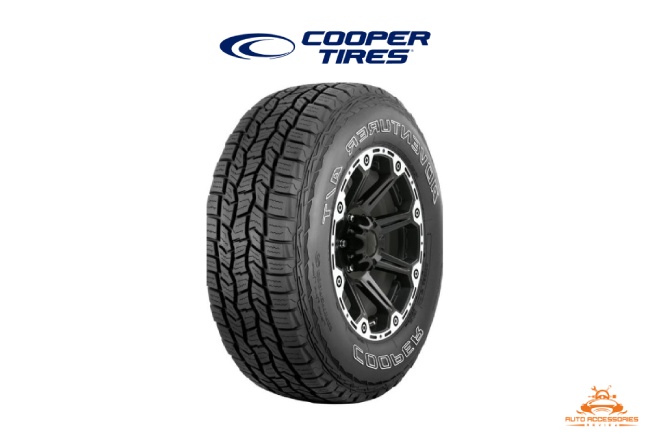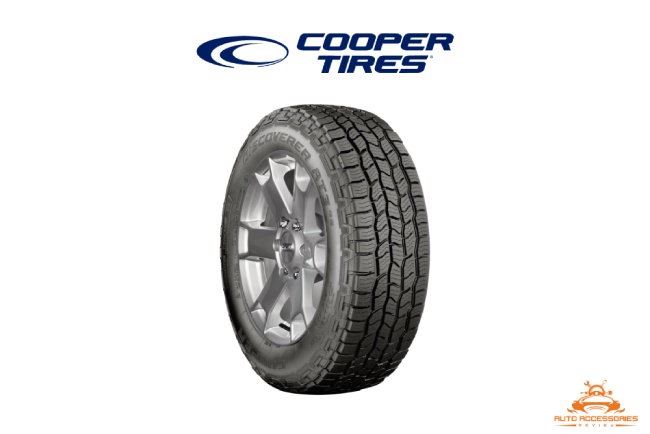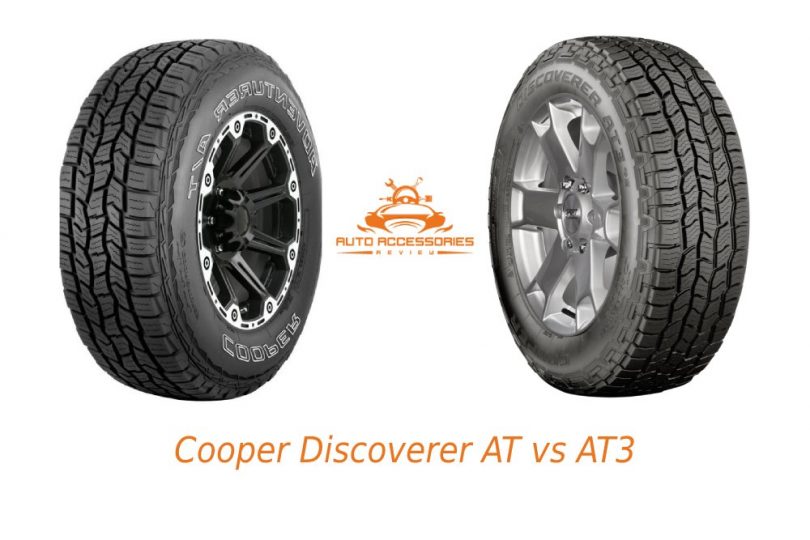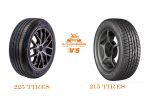Tires are a very broad subject, so it pays to do your research before you switch out the ones on your car that are currently balding.
Cooper is a household name in the tire industry who have been going for more than a century. When it comes to fitting your SUV or light truck, look no further than either the AT or AT3 from the Cooper Discoverer range.
These all-terrain (AT) tires strike a great balance between a smooth, high-traction on-road drive and aggressive off-road performance. They’re similar in design, but you’ll notice the AT is about $100 cheaper per tire than the AT3. The AT is a cheaper, arguably lower-quality model made specifically for Walmart retail.
Cooper Discoverer AT – Pros and Cons

Pros
- Off-road traction in sand, gravel, snow, and ice
- 55,000-mile warranty
- Quiet on freeways
- Quality on-road performance
Cons
- More difficult to find
- Can’t be serviced everywhere
Cooper Discoverer AT3 – Pros and cons

Pros
- 60,000-mile warranty
- Less wear with heavier loads
- 10ft shorter braking distance on wet surfaces
Cons
- Reduced on-road performance
Cooper Discoverer AT vs AT3 – What’s the difference?
Tire noise
Off-road tires tend to make a lot of noise at high speeds. Deep treads mean more space for air to flow. If you’ve ever driven in an open vehicle with large, off-road tires, you’ll notice at higher speeds your tires make a loud droning sound. So, between the AT and AT3, which is quieter?
The AT3 is a slightly higher-quality AT tire. Peculiarities in the tread design make it slightly noisier, though you’re unlikely to notice.
If you’re deciding on a tire based on how much noise it makes, you’re better off going for the AT3.
On-road traction
Both tires have performance on-road traction but given that the AT3 is designed for heavier loads, and with a greater focus on off-road, the AT3 performs better off than on-road.
So, if rough terrain is where you’re headed, take the AT3. However, if you’re just a Sunday driver, the Cooper AT will perform great on the freeway.
Off-road traction
As mentioned above, the AT3 is designed to tackle harsh terrain under a heavier load. On tarmac, it won’t feel as good as the AT.
Snow performance
The AT3 features zigzag snipes and sawtooth silica-based treads. Things get dodgy on the ice but the AT3 is a solid tire when tackling snow, providing good traction regardless of the snow type.
The AT sports all the tread technology as its AT3 counterpart. However, as a lighter, less aggressive tire, it may be marginally less suited to the snow.
If you want an AT tire for everything off-road, including snow and water, get an AT3.
Rocky performance
Performance on rocky surfaces can be inferred from each model’s abilities off-road. The AT slightly better suited to the road while the AT3 can handle rough terrain better than the former.
Given its better performance off-road, the AT3 will provide more grip when it handles gravel and rocks
Comfort
The rugged, aggressive build of the AT3 is suited to those who prefer those kinds of drives. They aren’t noisy for much of their mileage, but you can expect some airflow in the treads once you’re at the upper limits of its lifetime.
The AT, however, is closer to the highway end of the all-terrain spectrum. On road, it’s smooth and handles well. The AT3 isn’t noisy either, but you’ll find it’s a better tire on the tarmac.
If you’re looking for a smooth drive, the AT might be marginally better. These are all-terrain tires at the end of the day, but Cooper has done a great job as a solid all-rounder.
Durability
Both the Cooper Discoverer model tires are designed to maximize tread lifetime. You can expect to be driving on either set for up to 4 years!
That being said, the AT3 comes with a 60,000-mile warranty as opposed to the AT’s 55,000 and is designed to better handle off-road terrain under heavier loads.
So, you can expect the AT3 to keep its tread for longer.
Load capacity
The Cooper Discoverer AT can handle up to around 3748lbs per tire. The AT3 can take slightly more, at 4079lbs per tire. It’s designed for heavy-load vehicles carrying cargo on rough terrain, so expect to carry more on the AT3.
Clearly, if you need to haul more, the AT3 is for you.
Acceleration
AT tires aren’t as fast on the road as standard highway terrain (HT) tires, but they don’t disappoint. The AT is slightly better suited to the road, offering less performance off-road than the AT3. The AT3 is a tire that can handle the dirt better than the AT.
When it comes to acceleration on the road, the AT will translate that horsepower a bit better.
Handling
Both Cooper Discoverer AT and AT3 model tires will give you a soft ride with good traction, but their handling will still feel slightly different. On the road, the AT will turn tighter while still maintaining that comfortable and quiet ride.
The AT3 performs slightly better on the dirt and gravel. You’ll climb hills faster and take corners with more control than the AT.
Which tire handles better depends on what you’re looking for. If you expect to be off-road more, the AT3 is preferable. If you’re just on the road but you need something well-rounded, the AT offers better handling.
Fuel consumption
Under testing, the Cooper AT3 only dropped fuel economy by 0.5mpg. This was after switching out the stock AT highway tires.
AT tires are generally more efficient. They’re slightly lighter and slightly less bulky than the AT3 counterpart. The difference isn’t a lot, but if it matters to you, the AT is easier on the tank.
Speed rating
Both tires have an S-speed rating. However, they both handle slightly differently off and on-road. The AT performs better on road surfaces, so you can expect it to clock slightly faster speeds than the AT3 on the same surface.
They both have the same rating, but on the road, you’ll likely find the AT faster.
Tire Weight
The AT has an assembled product weight of 48.942lbs (per Walmart). This is slightly lighter than the AT3, coming in at 50.04lbs.
For a driver optimizing for weight, you’ll want to fit the AT’s. Even though the difference isn’t very significant, every pound counts!
Performance
Featuring Even Wear Arc technology, both tires are designed to apply load specifically to the tire-road contact surface for optimal wear distribution. You can expect to get between 55 and 60,000 miles out of them before needing replacements.
They’ll get you the traction and tight handling you’ll need on and off-road, but they still have their differences.
Performance depends on where you take them. The AT3 will last longer and perform better on the surface’s it’s designed for; rough, rocky, and hard.
The AT, while just as much of an all-terrain tire, will get you more out of highway terrain, and will certainly lost longer on those surfaces.
So, which to choose based on performance? It depends what surfaces you’re taking them on. More on that later.
Price
The AT goes for around $150 from Walmart while offering all the specs of the AT3, the latter costing you around $250.
If you’re looking for something cheap, the AT is a good deal. However, the price difference given the similarity in specs begs the question, what corners have been cut?
When should you use the AT?
The AT, as the name implies, is a solid tire for any surface. It features all-season tread technology that gives it respectable performance in any environment, come rain or snow. However, if you put it on an all-terrain spectrum, the AT is slightly more suited to the black roads.
If you want a great all-rounder but you find yourself on the highway much more than the backroads, take the AT’s.
When should you use the AT3?
The AT3 is a noticeably more rugged, heavier-load tire. It’s been designed for medium-to-heavy loads on the roughest terrain and excels on those surfaces.
If you need a workhorse on the gravel, you’ll need the AT3s.










Leave a Comment